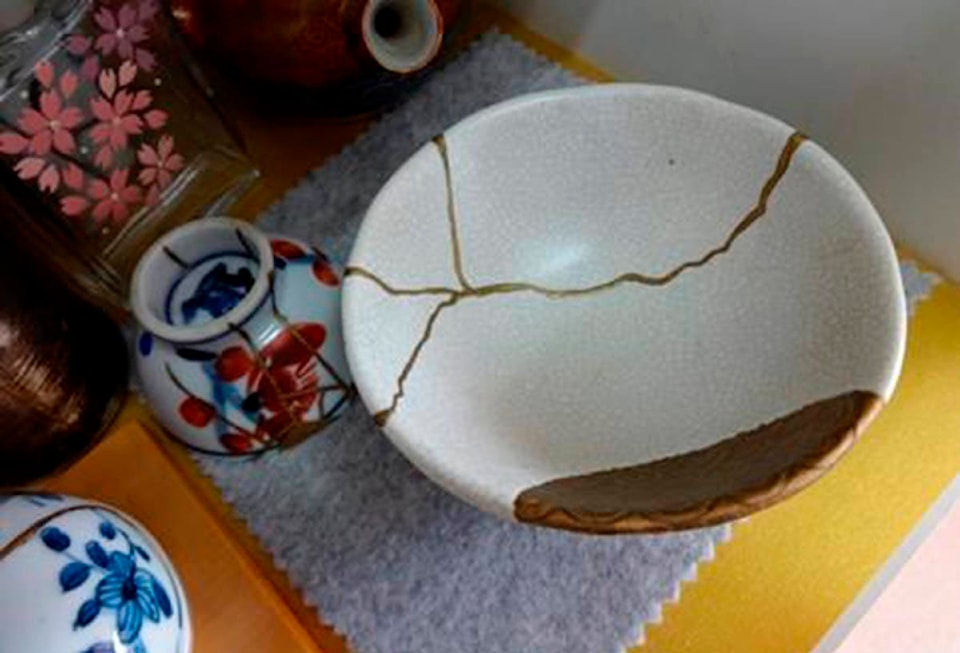If you search online for “kintsugi,” most of what you’ll find in English is self-help advice that uses this Japanese craft as a jumping-off point. The idea of repairing broken pottery in a way that makes it more beautiful than it was before is apparently an irresistible metaphor for recovering from life’s trials and tribulations.
When I tried kintsugi for myself at a workshop in Tokyo recently, I couldn’t help wondering how many of those writers based their simile on hands-on experience. The craft was a lot more tedious than I’d expected — but maybe that made the metaphor all the more true?
The usual goal when repairing something is to make the fix unnoticeable, restoring an object as closely as possible to its original appearance. Kintsugi takes the opposite approach: Chips and cracks are outlined and filled in with gold, creating a new design and adding a material that looks precious.
The craft is said to go back to the 15th century, and I was disappointed at first to learn from instructor Yoshiko Kuge that we would not be using traditional materials. The reasons soon became obvious, though. Of course it makes sense that beginners wouldn’t be using real gold — the usual replacement is a powder made of copper and brass — but, in addition, the ancient method took literally months to complete.
Kuge demonstrated the old technique by mixing a little sticky plant resin with clay powder, and then dripping a drop of it onto a chip on the lip of a cup. That was it for today: Now, you’d have to wait a month for that thin layer to dry, then repeat the process until enough layers had been built up to fill the gap.
Instead, we would use an epoxy putty that dries in a few minutes — an obvious improvement as far as speed, especially for a two-hour class. It’s also not as toxic as the old-fashioned materials, which can cause allergic reactions.
The workshop had many beautiful examples on display of pottery broken into several pieces and reassembled with lines of gold, as well as some with decorative additions incorporated, like pieces of sea glass. We, however, started small, each choosing a cup that was intact except for a small chip on its rim.
We each filled in the chip with a lump of putty that extended beyond the gap in all directions. After the putty dried, the next step was filing down the lump using a metal file that’s flat on one side and curved on the other — flat for the outside of the cup, curved for the inside.
The gold of a finished kintsugi piece is textured, so we students were a bit surprised as we kept showing our pieces to the instructors and being told we weren’t done yet. Turns out the texture is completely due to the gold added later — we really needed to file the filler down till it was completely level with the original surfaces, a process that took quite some time. Then, when it looked like it was finally perfectly smooth, we had to make it even smoother with wet sandpaper so fine you can’t feel any roughness with your fingertip.
At this point, the piece would normally be left to dry overnight, but so the workshop could be finished in one afternoon, Kuge effected a little time-travel with the use of a hair dryer. Once the piece cooled off, finally we got to what we came for: the gold.
In a tiny tray, the gold powder (made of brass and copper) is mixed with a resin; this is made from cashew nuts and is apparently less toxic than the traditional kind. We dipped a fine-tipped brush into some thinner and then into the gold mixture and used it to first outline our chip, then fill it in. (This is harder on the inside of the cup, where it’s hard to get a good angle.) Next we got to indulge in a tiny bit of artistic license: When you paint the fine crack that extends from the bottom of the chip, no one’s going to know if you make it a little longer than it really was. A more experienced craftsperson can also add designs to flat areas; Kuge showed us examples covered with tiny dots and with traditional patterns of nested half-circles.
Finally, with a larger brush, we took more of the dry powder and dusted it onto everything we’d just painted. At first, we needed to be careful not to touch the wet surface, but once it was covered with powder, it was safe to brush off the extra.
Although this didn’t take the months of waiting that it did in earlier centuries, we still were not quite done: After two days we’d need to wash the extra gold powder off with soapy water and a sponge, and then wait two weeks for the piece to dry completely.
If you want to try kintsugi, you can buy Japanese-made kits with all the materials. These will cost over $100 if you wait to go home to the U.S. and order them online, but even if you’re shopping in Japan they’re pricier than buying the components separately. Kuge provides students with a shopping list (with photos, for the Japanese-impaired).
The shopping list was a nice gesture, but for my part, what I learned about this craft is that I’m going to leave it to the experts, as least for pottery. As far as the life metaphor, I’ll have to think on it.
Linda Lombardi, The Associated Press



